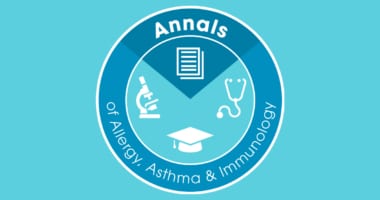 We are well into the holiday season and tomorrow is New Year’s Day. Hopefully you are contemplating your New Year’s resolutions and you have spending more time reading the Annals of Allergy, Asthma and Immunology on your list. We have many good features in our December issue that can assist you in your practice.
We are well into the holiday season and tomorrow is New Year’s Day. Hopefully you are contemplating your New Year’s resolutions and you have spending more time reading the Annals of Allergy, Asthma and Immunology on your list. We have many good features in our December issue that can assist you in your practice.
One article that struck me as particularly interesting is a clinical perspective from Peter Elias, MD, and Jeffrey Sugarman, MD, PhD, from San Diego. They address the issue of using moisturizers versus actual skin barrier repair in the management of atopic dermatitis (AD). For many of us more senior clinicians, classic dogma for AD management involved various strategies that almost invariably include manipulations designed to moisturize skin. This article goes beyond that with an excellent review of the pathophysiology of AD as a basis for recognition of the need to repair the skin barrier function which is damaged in AD. They review various approaches within this context. It will update your thinking and allow those of us caring for these patients to better define specific therapeutic approaches with a firmer grasp of mechanism for the specific products we prescribe.
Finally, John Oppenheimer, MD, FACAAI, and Larry Borish, MD, FACAAI, provide a brief update to our very successful Asthma Yardstick, originally published Feb. 2017. These recommendations for sustained step-up therapy largely manifest as the use of biologics that were not available a year ago. The authors provide mechanistic rationale that might, at some point in the future, separate products that have similar asthma phenotype targets but different mechanisms of action. They also describe the potential utility of newer biological therapies that are still in development or have very recently been approved by the Food and Drug Administration for asthma (i.e. Dupilumab). They end with a discussion of potential therapies currently being evaluated for T2 low asthma. Even with this expanding armamentarium, we still are left to largely “guess” which specific agent to use in which specific patient. Research addressing that very question is being actively pursued, and we are all hopeful for some more definitive answers in the near future.
Let me end by saying how very much I have enjoyed being a part of the Annals team this past year. This was an extra-special treat for me as I thought 2017 would be my final year as editor-in-chief. But there is more ahead! We have an outstanding team, including:
- Executive Editor Donald Leung, MD, PhD, FACAAI.
- Deputy Editors Anne Ellis, MD, MSc, FACAAI, and Anna Nowak-Wegrzyn, MD, FACAAI.
- Associate Editors Marianna Castells, MD, PhD, FACAAI; Mitchell Grayson, MD, FACAAI; Matthew Greenhawt, MD, MBA, MSc, FACAAI; Jay Lieberman, MD, FACAAI; John Oppenheimer, MD, FACAAI; and Jonathan Spergel, MD, PhD, FACAAI.
- Our excellent 56-member editorial board.
- All the reviewers who provided expertise and perspective that is essential for us to select the best article for publication.
A special thanks also goes out to our editorial office led by managing editor Elizabeth Marshall, RN, our College liaisons Kari Castor, Mandy Spejcher and Nancy Ryan, our publisher Elsevier led for us by publishing executive Terri Monturano and publication manager Debbie Stone, and the College’s Publications Committee led by Bryan Martin, DO, FACAAI. They have all been so supportive of our efforts to improve our journal.
And, of course, none of this would matter without the support of you, our readers. We all wish you a very Happy New Year with joy and success in 2019 and beyond.
Gailen Marshall Jr., MD, PhD, FACAAI
Editor-in-chief

